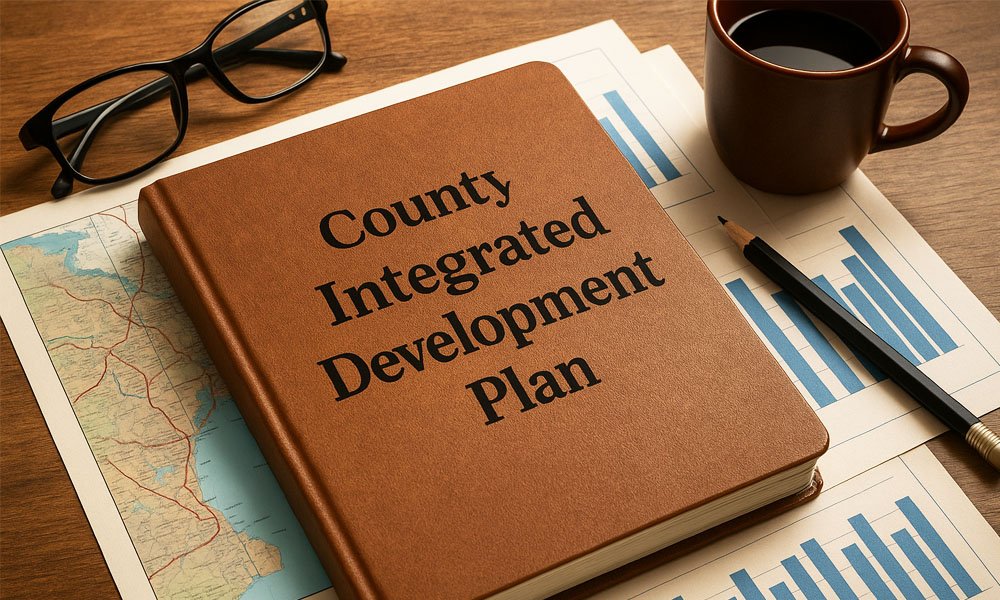Guide
What Is County Integrated Development Plan?: Everything to Know
Published
4 months agoon
By
Archie
Imagine living in a town where roads are broken, clinics are too far, and schools have no books. Then one day, things slowly start to improve—a new health center opens, the road gets fixed, and there’s even a market with clean water nearby. These changes don’t just happen by luck. They are planned ahead. And that’s exactly where the County Integrated Development Plan comes in.
In Kenya, counties don’t just guess what to build or where to spend money. They follow a clear plan called the County Integrated Development Plan, or CIDP. This plan decides what each county will do over a 5-year period. From small villages to big towns, everything is guided by this one important document.
In this article, we’re going to explain what the County Integrated Development Plan is, how it works, who creates it, and why it matters to every Kenyan. Whether you’re a student, a leader, or a curious citizen, this guide is made just for you—in simple, easy words.
What Is a County Integrated Development Plan (CIDP)?
Let’s start with the basics.
A County Integrated Development Plan is a five-year plan that every county in Kenya must create. It shows what the county wants to do and how it plans to do it. It includes things like:
-
Which roads to build
-
What health services to improve
-
Where to put new schools or water projects
-
How much money is needed for each project
Think of it as the county’s “to-do list” for the next five years.
But it’s more than just a list. It’s a legal requirement. Every county must follow this plan when making its budget and development decisions. If something is not in the CIDP, the county usually cannot spend money on it.
So, if your county builds a new hospital, repairs a road, or installs a borehole, chances are it was part of the CIDP.
Why Is the CIDP So Important for Counties?
You might wonder—why do counties need such a plan? Can’t they just do what they think is best?
The answer is simple: good planning brings good results. Without a plan, money can be wasted, projects may overlap, and people’s needs may be ignored.
Here’s why the CIDP is so important:
-
It gives direction – The plan helps counties focus on what matters most.
-
It controls the budget – Counties can’t spend randomly. The plan guides where money goes.
-
It protects public money – By following a written plan, counties reduce corruption and waste.
-
It connects to Kenya’s big goals – CIDPs help counties support national plans like Vision 2030, The Big 4 Agenda, and the Sustainable Development Goals (SDGs).
Let’s take an example: If the national government wants better healthcare, your county can add more clinics or train more nurses as part of its CIDP. This way, everyone works toward the same goal—from village to nation.
Who Decides What Goes Into a CIDP?
Now, you might ask—who writes this plan? Is it only done by politicians?
The good news is: everyone has a role.
Here’s how it works:
-
The Governor and County Executive Committee (CEC) are in charge of preparing the plan.
-
The County Department of Planning and Finance helps write it and organize the process.
-
Most importantly, citizens give their input.
Yes, people like you can help shape the CIDP. Counties hold public meetings where residents suggest what they need—maybe more classrooms, better roads, or farming support. These suggestions are then reviewed and, if possible, added to the plan.
There’s also a group called the County Budget and Economic Forum (CBEF). This team includes leaders from business, civil society, and the government. They help bring all voices together.
So the CIDP is not just made by leaders—it is made with the people.
What Does the CIDP Actually Include?
A County Integrated Development Plan is not just a single page with a few ideas. It is a full, detailed document that shows:
-
The vision of the county (what it wants to achieve)
-
The current situation (what’s already there, what’s missing)
-
The main goals and targets
-
A list of planned projects and where they will be done
-
How much money is needed, and where it might come from
-
Maps and data to show locations, population, and services
-
A plan to monitor progress and check if goals are being met
Each sector—like roads, water, health, education, farming, trade—gets its own section. The county writes what it wants to achieve in each area, how long it will take, and what it will cost.
For example:
-
In the Health section, the CIDP might say: “Build 5 new clinics in rural areas by 2026.”
-
In the Agriculture section, it might say: “Give farm tools to 3,000 small-scale farmers.”
Everything is clearly written so citizens and leaders can follow along.
How Is the CIDP Created? Step-by-Step Process
Creating a County Integrated Development Plan takes time and teamwork. It’s not something done in a week. It follows a legal and organized process that looks like this:
Review the Past Plan
The county checks the last CIDP. What projects were done? What failed? What needs to continue?
Collect Public Views
The county holds baraza meetings, ward forums, and stakeholder gatherings. People share their ideas, challenges, and suggestions.
Draft the Plan
Planners use all the information to prepare the first draft of the CIDP. They include national guidelines, public input, maps, and sector targets.
County Assembly Review
The draft is shared with the county assembly. Members debate it, suggest changes, and finally approve it.
Publish the Final Plan
The final version is published online and in print. It becomes the official guide for county development for the next five years.
This whole process usually starts right after county elections, and the new CIDP must be ready by September 1 of that year.
How Often Is a New CIDP Made?
A County Integrated Development Plan is not forever. It only lasts five years. After that, a new one must be made.
The cycle looks like this:
-
First CIDP: 2013–2017
-
Second CIDP: 2018–2022
-
Third CIDP: 2023–2027 (currently in use as of 2025)
Each new CIDP builds on the one before it. If a project was not finished in the last plan, it can be continued in the new one. This keeps progress moving forward.
And remember: every new governor must work with the existing CIDP or help update it—because it’s the law.
Public Participation: Why Your Voice Matters
One of the best things about the County Integrated Development Plan is that it includes everyday people. You don’t have to be a government officer or politician to have a say in what your county plans.
When a county starts working on a new CIDP, they invite the public to take part. You might hear about a baraza meeting in your ward or a notice calling people to a town hall discussion. This is your chance to say what your community really needs.
For example, maybe your area has a water shortage. Or maybe children walk too far to school. You can raise these issues during these meetings, and they may be added to the new CIDP. In fact, some counties have changed their priorities because local people spoke up.
In short, public participation makes the plan real. It makes sure leaders don’t just guess what people need—they actually ask.
How the CIDP Connects with Other County Plans
The County Integrated Development Plan is the main plan—but it’s not the only one. It connects with other county documents that help guide day-to-day work and budgets.
Let’s look at a few important ones:
Annual Development Plan (ADP)
This is the one-year version of the CIDP. It shows which projects from the big five-year plan will be done that year.
County Fiscal Strategy Paper (CFSP)
This paper gives details about money—how much the county can spend, and what the priorities are. Again, all based on the CIDP.
Programme-Based Budget (PBB)
This is the actual county budget. It lists the amount of money going to each department and program—again, guided by the CIDP.
Sectoral and Spatial Plans
Some counties also have long-term plans for farming, housing, or land use. These must also agree with what’s in the CIDP.
All these documents work together. The CIDP is like the big map, and the others are the smaller tools to help follow the map.
What Challenges Do Counties Face with CIDPs?
Even though CIDPs are powerful tools, not every county uses them perfectly. Some face real challenges that slow down progress or block results.
Here are a few common problems:
Poor Implementation
Some counties make beautiful plans but don’t follow through. Projects may stay on paper and never get built. This could be due to poor leadership, slow processes, or lack of follow-up.
Limited Funds
Even with good plans, many counties don’t have enough money to do everything they want. They rely mostly on funds from the national government, which may not be enough.
Low Public Awareness
Many people don’t know what a CIDP is, or that they can take part in it. As a result, some county projects miss the mark because people’s voices were never heard.
Political Interference
Sometimes, leaders change the plan based on personal or political interests. They might move a project to an area just because they got more votes there. This hurts fairness and slows real progress.
Despite these issues, many counties are learning and improving with each new CIDP.
Real Examples of CIDPs in Action
Let’s look at how some counties have used their County Integrated Development Plan to make real change.
Makueni County
This county became famous for using its CIDP to bring health services closer to the people. It started a Universal Health Coverage program, built hospitals, and reduced costs for medicine. All of it came from what was written in the CIDP.
Kisumu County
Thanks to its CIDP, Kisumu focused on clean water and good markets. It upgraded water supply lines and built modern stalls for traders. These projects helped small businesses grow and improved hygiene.
Laikipia County
Laikipia used its CIDP to improve how it collects revenue. They went digital—meaning less money was lost, and more was available for public services like roads and street lighting.
These stories show that CIDPs work when counties take them seriously.
Bottom-Line
So, why should you care about the County Integrated Development Plan?
Because it’s your future. Your hospital, your roads, your school—all of them can be improved through proper planning. The CIDP is not just a government document—it’s a promise. A promise that your county will focus on real needs and spend money in the right way.
When people take time to understand the CIDP, ask questions, and speak up, counties perform better. That’s why the law says public participation must be part of the process.
As we move deeper into 2025 and beyond, all 47 counties are now following the 2023–2027 CIDP cycle. There’s still time to learn what’s in your county’s plan. You can visit the county website, attend a forum, or ask your MCA about it.
The next time you see a new clinic or school opening near you—remember, it likely started with the County Integrated Development Plan.
(FAQs)
Can a county spend money on a project that’s not in the CIDP?
No! By law, counties cannot fund any project that’s not listed in the County Integrated Development Plan. If it’s not in the CIDP, it legally shouldn’t happen.
Do citizens really have the power to change a county’s development plan?
Yes! Ordinary people can attend public forums and request new projects. Some counties have even cancelled or moved projects based on what citizens said!
Are some CIDPs just copied from old ones?
Sadly, yes. Some counties recycle old plans with little change, leading to repeated failures and wasted budgets. It’s a big problem when leaders don’t take planning seriously.
What happens if a county doesn’t make a CIDP?
The county is breaking the law. Without a valid CIDP, it cannot make a proper budget, and the national government may withhold funding.
Is it true that some CIDPs promise projects that never happen?
Yes. Many counties list huge projects they can’t afford just to impress voters. These “ghost projects” often never get started—even though they look great on paper.
Other Articles You May Read:
You may like


How to Plan a 48-Hour Luxury Trip to London

Benefits of Partnering with an Expert Foundry

Choosing the Right Supported Independent Living Option for Your Needs

Why Companies Worldwide Are Hiring Power BI Developers

Experience Pure Android Gameplay with MuMuPlayer Emulator

A Guide To Solar PV For Homeowners

How to Convert a Historic Building into a Hotel: a 2025 Guide

How You Can Integrate AI into Your Small Business For Faster Growth

File Recovery on Android: Myths vs. Facts

Cooler, Safer, Clearer: Why Quality Window Tint Is a Smart Upgrade in 2025

Carol Kirkwood’s Journey: Her Real Age, Husband, Career, and More

Revolutionizing Healthcare: The Emergence of AI-Driven Analytics

How Machine Learning and AI are Redefining the Future?

Aliza Barber: Meet Lance Barber’s Wife, Age, Life, Profile, Career and Net Worth

Evelyn Melendez: Jordan Knight’s Wife Bio, Marriage, Family, Career and Net Worth

Ilan Tobianah Biography: Family, Marriage, Lifestyle, Career and Net Worth

Who was Alice Marrow? Everything to Know About Ice-T’s and His Mother

King Von’s Autopsy Report: The Truth Behind the Tragic Death

Meet Otelia Cox: The Supportive Wife of Tony Cox – A True Fairy Tale Romance

Tea Leoni and Tim Daly Split – A Closer Look at Their Relationship and Breakup

How to Plan a 48-Hour Luxury Trip to London

Benefits of Partnering with an Expert Foundry

Choosing the Right Supported Independent Living Option for Your Needs

Why Companies Worldwide Are Hiring Power BI Developers

Experience Pure Android Gameplay with MuMuPlayer Emulator

A Guide To Solar PV For Homeowners

How to Convert a Historic Building into a Hotel: a 2025 Guide

How You Can Integrate AI into Your Small Business For Faster Growth

File Recovery on Android: Myths vs. Facts

Cooler, Safer, Clearer: Why Quality Window Tint Is a Smart Upgrade in 2025
Category
Trending
-

 News3 months ago
News3 months agoCarol Kirkwood’s Journey: Her Real Age, Husband, Career, and More
-

 Health2 years ago
Health2 years agoRevolutionizing Healthcare: The Emergence of AI-Driven Analytics
-

 Technology2 years ago
Technology2 years agoHow Machine Learning and AI are Redefining the Future?
-

 Celebrity2 years ago
Celebrity2 years agoAliza Barber: Meet Lance Barber’s Wife, Age, Life, Profile, Career and Net Worth
